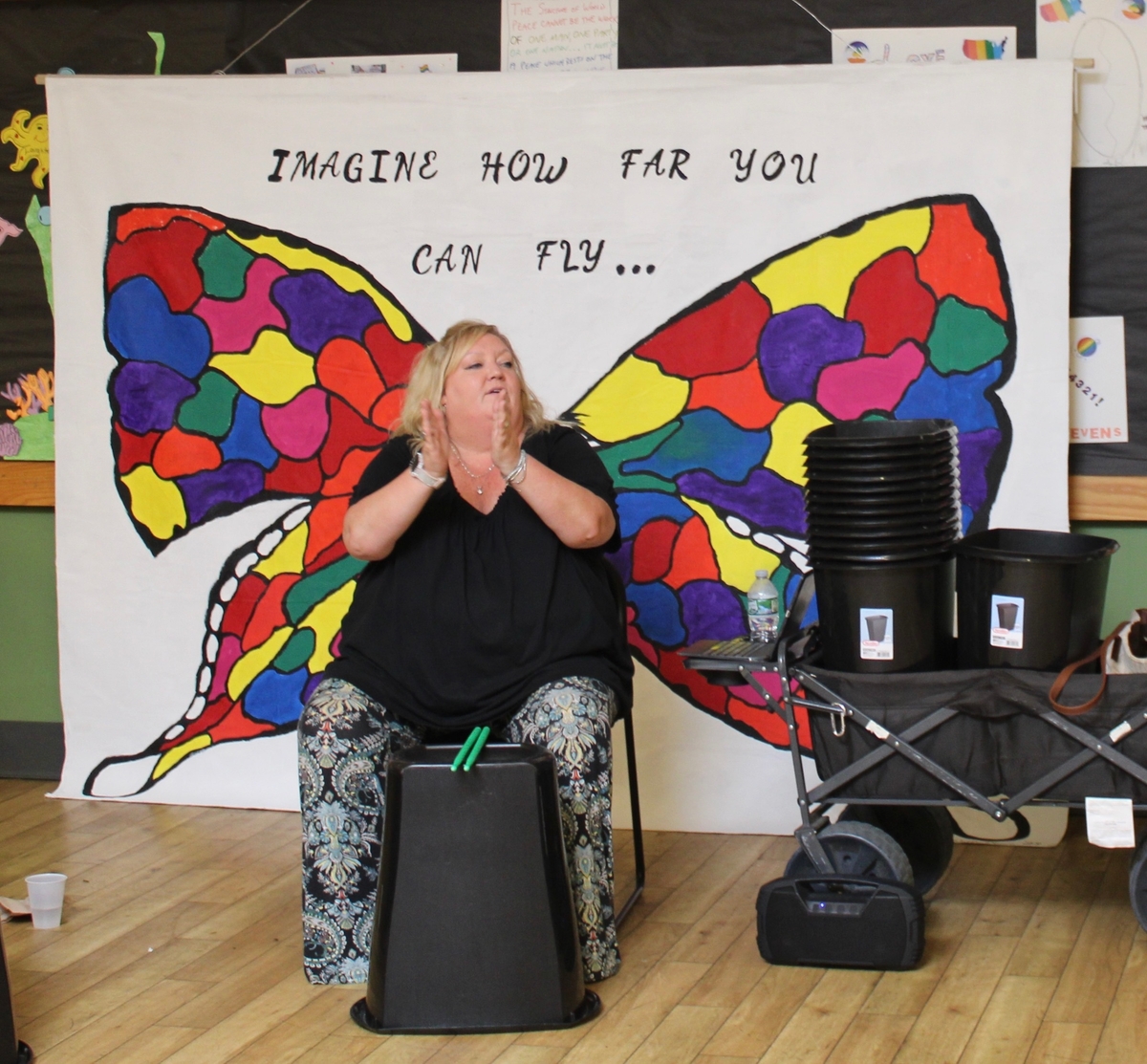
Eleanor Polak Photos
Kristie Entwistle leads a group in seated dance at Fellowship Place.
Six members of the Artship Artists’ Cooperative at Fellowship Place, an agency that provides therapeutic support and rehabilitation services for adults living with mental illness, sat in a circle of chairs in front of a butterfly mural. Each person had a large container in front of them and a pair of drumsticks in their hands. As the Beatles’ “Ob-La-Di, Ob-La-Da” played on the loudspeakers, dance instructor Kristie Entwistle led the group in seated dance filled with hand-clapping, swaying, and beats on the drums.

Eleanor Polak Photos
A group painting at Fellowship Place.
Artship offers these dance classes, along with sessions in writing, singing, and the visual arts, as a therapeutic alternative to traditional talk therapy. “All of these programs are so important because many of the people who have mental health problems have trouble sitting down for talk therapy, but art is a non-threatening and easy way for them to express themselves,” said Mary Guerrera, executive director of Fellowship Place. She believes that the art classes offer an alternative method of teaching skills that apply to other areas in life, like organization, concentration, and social skills.
Many of the members of Fellowship Place “have a hard time organizing themselves to complete a task or follow instructions,” said Guerrera. But put them in a dance circle with Entwistle and they can develop concentration and coordination skills that “help them organize their grocery list, or pay their bills.” The groups also foster a peer-support network that encourages cooperation and helps members to make friends. “To have a peer-support network that faces the same challenges they do is transformative. Getting over most things requires social connection,” explained Guerrera. “It opens up a whole world for them.”
That world is filled with opportunities for participants to learn new hobbies and boost confidence. Members of Artship get the chance to create work that they can take pride in, exhibited in regular art shows where artists display and sell their work, or in a quarterly journal filled with stories and poems. They can also give back to the community. Members painted the butterfly mural in the main room as a group project for the Friends of Kensington, to serve as a backdrop for a Fourth of July picnic.

Eleanor Polak Photos
Alyssa Guarino in the art room.
Alyssa Guarino, expressive arts coordinator and recovery advisor, emphasized the benefits of art therapy as a way to work through emotions too complex to vocalize. “It’s really important for members to use art for expression because it can be hard to express things in words,” said Guarino. Dance, art, and writing can take a feeling that feels immense and uncontrollable and turn it into something tangible.
“I can get my darkest, darkest out through art therapy,” said Joanna Stewert, who has attended the program since 2018. She described art as a kind of exorcism, releasing something painful built up inside of her onto the medium of the blank page. For Stewert, “the end of group is like a big sigh,” but her best days are the ones spent at Fellowship Place art classes.
Entwistle teaches Music and Movement, a group founded by the Jamie Hulley Arts Foundation. Her class started as Latin dance, then added ballroom in response to one member’s request for Frank Sinatra, and evolved over time into freestyle, freeform dance. Entwistle believes in the empowering effects of dance. “After a while, the clients started to gain confidence,” she said. “I asked one week if someone wanted to lead the class, and now some days the whole class leads and I don’t have to do anything.”
“I could be at a zero when I come in, and I leave at a nine,” said Elizabeth Thompson, one of the members of Artship. “I really need this group.”

Eleanor Polak Photos
Joanna Stewert next to her painting.
Members have the option to lead their own groups, something that inspired nervousness at first but built confidence over time. Stewert led an art project using rubber balls and string instead of paintbrushes, inspired by her attempts to occupy her young children on a limited budget. She explained how the colors she used in her painting helped her to express her emotions. “There’s so much darkness stuck inside me that I need to get out,” she said, gesturing to her vibrant and expressive work. “The red is anger and hate, the purple is domestic violence, and those bits of blue are happiness.”
Artship allows members to express themselves in whatever way helps them best. Sometimes, that isn’t sitting across from somebody at a desk and telling them your life story. Sometimes, that means paint, music, and community.
“That’s what’s really nice about Fellowship Place,” said Guerrera. “Everyone has a choice. It’s not like going to a psychiatrist and getting a prescription, being told to come in twice a week. Here, they get to tailor their own schedules.” Choice means deciding what your self-expression looks like, and that’s a little different for everyone. It could look like talk therapy, or writing, or playing drums in a circle with your peers. It could even look like a butterfly, bright colors splashed across the wall, almost ready to take flight.

Fellowship Place artists have been adding art to the parks in Dwight for decades. The rainbow sign over the entrance to Rainbow Park is one example. Last summer the Parks Department allowed the Artship Artists Collective to paint new plastic barrels that now grace Kensington Playground, adding color and art to the landscape. The Dwight neighborhood is very fortunate to have Fellowship Place. We benefit very much from their consistent engagement as full partners with the community. We thank them for the beautiful wings that will be part of the annual neighborhood event on Saturday.